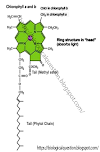Ascent of Sap
Water and minerals are absorbed by the root epidermal cells of soil from where these substances are first moved the root xylem cells and then to the leaves. This upward movement of water and dissolved mineral from root to the leaves through xylem tissue is called ascent of sap. Since this movement occurs against the gravity therefore, a considerable force is required to conduct water and minerals in tall heighted plants. The most acceptable theory that explain this movement is generally called TACT theory.
TACT theory
According to this theory, four factors such as Transpiration pull, Adhesion, Cohesion and Tension (TACT) are combined to form a collective force that is mainly responsible for ascent of sap.
1. Transpiration pull
When stomata are open, the water molecules move from the region of high water potential (intercellular spaces of leave) to a region of low potential (in the air). This evaporation of water is called transpiration. In the same way the dry intercellular spaces pull water from surrounding cells which in turn pull the water from the xylem tissue. Thus, the phenomenon of transpiration develops a pulling force, the transpiration pull that compels the water and minerals to move upward through the xylem.
2. Adhesion
Adhesion is the attractive force between water molecules and other substances. Because both water and cellulose are polar molecules so there is a strong attraction for water within the hollow capillaries of the xylem. Adhesion of the string of water molecule to the wall of the xylem cells assists upward movement of the xylem sap counteracting the downward gravity. Adhesion also helps to hold water in the xylem when transpiration is not occurring.
3. Cohesion and tension
Water molecules attract one another, forming weak hydrogen bonds. This attraction among water molecules is called cohesion and the hydrogen bonds formed between them are termed as tension.
Mechanism of TACT force
The column of water molecule within the xylem is at least as strong and as unbreakable as a steel wire of the same diameter. Hydrogen bonds among water molecules provide the cohesion that holds together the 'string' of water extending the entire height of the plant within the xylem. As long as transpiration continues, the string is kept tense and is pulled upward as one molecule. The bulk flow of water to the top of a plant is driven by solar energy since evaporation from leaves is responsible for transpiration pull.
Movement of Water in Xylem through TACT Mechanism
Thank you Reading the Article.



.png)

.png)
0 Comments